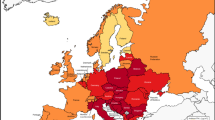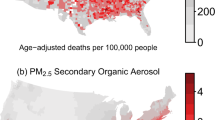Abstract
In this paper, the pooled NO2 association with nonaccidental mortality is examined across 10 cities in Canada in single- and two-pollutant time-series models. The results reaffirm that NO2 has the strongest association with mortality, particularly in the warm season. Although attributing such effects to NO2 cannot be ruled out, it is plausible that NO2 is acting as an indicator for some other exposure affecting the population. This could include PM2.5, as has been suggested from some personal exposure data, but it could also be indicating a more specific type of PM2.5, such as traffic-related particles, given that in cities the main source of NO2 is motor vehicle exhaust. NO2 could also be acting as a surrogate for other pollutant(s) originating from motor vehicles or high-temperature combustion, such as volatile organic compounds (VOCs) or polycyclic aromatic hydrocarbons. Another possibility is other oxidized nitrogen species (“NOz”) or photochemically produced pollutants that can co-vary with NO2, especially during urban stagnation events. Data to test these different possibilities across several Canadian cities are examined. The focus is on correlations in time or space between NO2 and other pollutants that are more strongly linked to vehicle emissions. The results support the hypothesis that NO2 is a better indicator than PM2.5 of a range of other toxic pollutants. This includes VOCs, aldehydes, NOz and particle-bound organics in motor vehicle exhaust. Thus, overall, the strong effect of NO2 in Canadian cities could be a result of it being the best indicator, among the pollutants monitored, of fresh combustion (likely motor vehicles) as well as photochemically processed urban air.
This is a preview of subscription content, access via your institution
Access options
Subscribe to this journal
Receive 6 print issues and online access
$259.00 per year
only $43.17 per issue
Buy this article
- Purchase on Springer Link
- Instant access to full article PDF
Prices may be subject to local taxes which are calculated during checkout



Similar content being viewed by others
References
Ayyagari V.N., Januszkiewicz A., and Nath J. Effects of nitrogen dioxide on the expression of intercellular adhesion molecule-1, neutrophil adhesion, and cytotoxicity: studies in human bronchial epithelial cells. Inhal Toxicol 2007: 19: 181–194.
Brook J.R., Dann T.F., and Burnett R.T. The relationship among TSP, PM10, PM2.5 and inorganic constituents of atmospheric particulate matter at multiple Canadian locations. J Air Waste Manage Assoc 1997: 47: 2–19.
Brook J.R., Graham L., Charland J.P., Cheng Y., Fan X., and Lu G., et al. Investigation of the motor vehicle exhaust contribution to primary fine particle organic carbon in urban air. Atmos Environ 2007: 41: 119–135.
Brunekreef B., Janssen N.A., de Hartog J., Harssema H., Knape M., and van Vliet P. Air pollution from truck traffic and lung function in children living near motorways. Epidemiology 1997: 8: 298–303.
Burnett R.T., Ross W.H., and Krewski D. Nonlinear random effects regression models. Environmetrics 1995: 6: 85–99.
Burnett R.T., Brook J.R., Dann T., Delocla C., Philips O., and Cakmak S., et al. Association between particulate and gas phase components of urban air pollution and daily mortality in eight Canadian cities. Inhal Toxicol 2000: 12 (Suppl.): 15–39.
Burnett R.T., Stieb D., Brook J.R., Cakmak S., Dales R., and Raizenne M., et al. The short-term effects of nitrogen dioxide on mortality in Canadian cities. Arch Environ Health 2004: 59: 228–237.
Chauhan A.J., Inskip H.M., Linaker C.H., Smith S., Schreiber J., Johnston S.L., and Holgate S.T. Personal exposure to nitrogen dioxide (NO2) and the severity of virus-induced asthma in children. Lancet 2003: 361: 1939–1944.
Curren K.C., Dann T.F., and Wang D.K. Ambient air 1,3-butadiene concentrations in Canada (1995–2003): seasonal, day of week variations, trends, and source influences. Atmos Environ 2006: 40: 170–181.
Fraser M.P., Cass G.R., and Simoneit B.R.T. Gas-phase and particle-phase organic compounds emitted from motor vehicle traffic in a Los Angeles roadway tunnel. Environ Sci Technol 1998: 32: 2051–2060.
Fraser M.P., Lakshmanan K., Fritz S.G., and Ubanwa B. Variation in composition of fine particulate emissions from heavy-duty diesel vehicles. J Geophys Res 2002: 107 (D21): 8346.
Garshick E., Laden F., Hart J.E., and Caron A. Residence near a major road and respiratory symptoms in U.S. veterans. Epidemiology 2003: 14: 728–736.
Government of Canada. Five-year progress report on Canada-wide standards for particulate matter and ozone. Environment Canada, January 2007, ISBN 0-662-44480-9.
Han X., and Naeher L.P. A review of traffic-related air pollution exposure assessment studies in the developing world. Environ Int 2006: 32 (1): 106–120.
Hays M.D., Smith N.D., Kinsey J., Dong Y., and Kariher P. Polycyclic aromatic hydrocarbon size distributions in aerosols from appliances of residential wood combustion as determined by direct thermal desorption – GC/MS. Aerosol Science 2003: 34: 1061–1084.
Henderson S.B., Beckerman B., Jerrett M., and Brauer M. Application of land use regression to estimate longterm concentrations of traffic-related nitrogen oxides and fine particulate matter. Environ Sci Technol 2007: 41: 2422–2428.
Hoek G., Brunekreef B., Goldbohm S., Fischer P., and van den Brandt P.A. Association between mortality and indicators of traffic-related air pollution in the Netherlands: a cohort study. Lancet 2002: 360: 1203–1209.
Kraft M., Eikmann T., Kappos A., Kunzli N., Rapp R., and Schneider K., et al. The German view: effects of nitrogen dioxide on human health—derivation of health-related short-term and long-term values. Int J Hygiene Environ Health 2005: 28: 305–318.
Lee P.K., Brook J.R., Dabek-Zlotorzynska E., and Mabury S. Identification of the major sources contributing to PM2.5 observed in Toronto. Environ Sci Technol 2003: 37: 4831–4840.
Mills N.L., Törnqvist H., Robinson S.D., Gonzalez M., Darnley K., and MacNee W., et al. Diesel exhaust inhalation causes vascular dysfunction and impaired endogenous fibrinolysis. Circulation 2005: 112: 3930–3936.
Rogge W.F., Hildemann L.M., Mazurek M.A., Cass G.R., and Simoneit B.R.T. Sources of fine organic aerosol. 7. Hot asphalt roofing tar pot fumes. Environ Sci Technol 1997: 31: 2726–2730.
Samoli E., Aga E., Toulouni G., Nisictes K., Forsberg B., and Lefranc A., et al. Short term effects of nitrogen dioxide and mortality: an analysis within the APHEA project. Eur Respir J 2006: 27: 1129–1137.
Sarnat J.A., Schwartz J., Catalano P.J., and Suh H.H. Gaseous pollutants in particulate matter epidemiology: confounders or surrogates? Environ Health Perspect 2001: 10: 1053–1061.
Schauer J.J., Rogge W.F., Hildemann L.M., Mazurek M.A., Cass G.R., and Simoneit B.R.T. Source apportionment of airborne particulate using organic compounds as tracers. Atmos Environ 1996: 30: 3837–3855.
Stieb D., Judek S., and Burnett R.T. Meta-analysis of time-series studies of air pollution and mortality: update in relation to the use of generalized additive models. J Air Waste Manage Assoc 2003: 53: 258–261.
Tonne C., Melly S., Mittleman M., Coull B., Goldberg R., and Schwartz J. A case–control analysis of exposure to traffic and acute myocardial infarction. Environ Health Perspect 2006; doi: 10.1289/ehp.9587 (available at http://dx.doi.org/) online 11 October 2006.
Urch B., Brook J.R., Wasserstein D., Brook R.D., Rajagopalan S., Corey P., and Silverman F. Relative contributions of PM2.5 chemical constituents to acute arterial vasoconstriction in humans. Inhal Toxicol 2004: 16 (6–7): 345–352.
Urch B., Silverman F., Corey P., Brook J.R., Lukic K.Z., Rajagopalan S., and Brook R.D. Acute blood pressure responses in healthy adults during controlled air pollution exposures. Environ Health Perspect 2005: 113: 1052–1055.
U.S. EPA U.S. Environmental Protection Agency Technical Assistance Document (TAD) for Precursor Gas Measurements in the NCore Multi-Pollutant Monitoring Network—VERSION 4 2005 Prepared by BATTELLE, Columbus, OH 43201-2693. Contract no. 68-D-02-061. EPA-454/R-05-003.
Wang D.K., and Austin C.C. Determination of complex mixtures of VOCs in ambient air: an overview. Anal Bioanal Chem 2006a: 386 (4): 1089–1098.
Wang D.K., and Austin C.C. Determination of complex mixtures of VOCs in ambient air: canister technology. Anal Bioanal Chem 2006b: 386 (4): 1099–1120.
Wheeler A.J., Xu X., Smith-Doiron M., Gilbert N.L., and Brook J.R. Intra-Urban Variability of Air Pollution—Monitoring and Modeling of PM2.5, PM2.5–10 and NO2 , Poster presentation at ISEE ISEA, Paris, September 2006.
Acknowledgements
We thank Orly Brion for programming support as part of the time-series analysis.
Author information
Authors and Affiliations
Corresponding author
Rights and permissions
About this article
Cite this article
Brook, J., Burnett, R., Dann, T. et al. Further interpretation of the acute effect of nitrogen dioxide observed in Canadian time-series studies. J Expo Sci Environ Epidemiol 17 (Suppl 2), S36–S44 (2007). https://doi.org/10.1038/sj.jes.7500626
Received:
Accepted:
Published:
Issue Date:
DOI: https://doi.org/10.1038/sj.jes.7500626
Keywords
This article is cited by
-
Air pollution and hospitalization of patients with idiopathic pulmonary fibrosis in Beijing: a time-series study
Respiratory Research (2022)
-
Global fine-scale changes in ambient NO2 during COVID-19 lockdowns
Nature (2022)
-
The relationship between short-term PM2.5 exposure and outpatient visits for acne vulgaris in Chongqing, China: a time-series study
Environmental Science and Pollution Research (2022)
-
Variations in the tropospheric concentration of NO2 in the central west of Brazil, MS, and their relationship with the COVID-19
Air Quality, Atmosphere & Health (2022)
-
Systematic review and meta-analysis of case-crossover and time-series studies of short term outdoor nitrogen dioxide exposure and ischemic heart disease morbidity
Environmental Health (2020)



